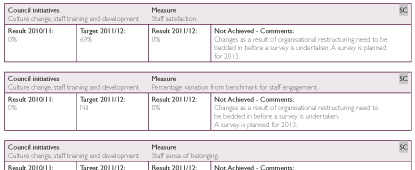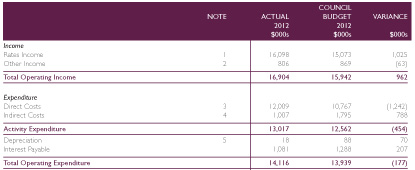At a Glance
Primary Services
- Human resources
Why We Do It
Council's aim is to recruit and develop high quality staff capable of providing excellent services to the people of the Far North. Key functions undertaken include:- Recruitment and selection.
- Development and management of HR policies and processes.
- Staff training and development.
- Management and administration of performance systems.
- Monitoring and reporting of staff numbers and costs.
What Has Changed Since The LTCCP 2009/19?
There have been no significant changes to the human resources activity since the 2009/19 LTCCP was published.Priorities For 2011/12 |
What We Have / Haven't Achieved |
|---|---|
| Completing the restructure to ensure Council becomes a lean organisation focused on delivering customer satisfaction | The major restructuring of Far North District Council has been completed. Some minor tweaks will be ongoing until the new structure settles in. FTE's have reduced by 15% since 2008. |
| Continuing to ensure Council is able to retain key skills and organisational knowledge | We have lost a few engineering staff to Australia as is the trend nationwide. Otherwise turnover in key skill areas has been minimal, primarily due to economic factors. |
| Stabilising the implementation of the new talent management system to increase accountability and lift performance | We have achieved a 98% compliance rate in completion of goal setting and appraisals in the past year. This is a significant achievement for the business. Goal setting is become more robust, as are achievements. |
| Enhancing the new HR information system to improve management reporting | Post implementation of our new payroll system in May 2012, and the integration of our HRIMS with it, management reporting improvements are starting to be realised. |
| Increasing the focus on Health & Safety both within Council and for council contractors to provide a safer workplace and reduce lost time and associated costs | Lost time due to OHS incidents has been negligible. |
| Capitalising on the findings from Project Opportunity to drive culture change in council by improving work practices, efficiency and effectiveness | Alignment of strategic priorities and key result areas from the LTCCP / Annual Plan process to individual goal setting, led to organisation working in the same direction. Continuous improvement culture being encouraged through staff initiated continuous improvement ideas. Staff numbers continuously monitored with like roles and sharing of resources across the organisation. Debt collection team in place, with managed debt recovery programme in place targeting all outstanding rating and sundry debt. |
| Ensuring staff job satisfaction and increased focus on customer service | A satisfaction survey is planned for 2013 to measure staff and job satisfaction levels. |
Future Issues / Challenges |
Implications |
|---|---|
| Developing a performance culture | Managing performance. |
| Improving human resource information management system (HRIMS) | A new HRIMS is improving the reporting efficiency reporting capability. We are to maximise capability for line manager use. |
| Implementation of shared service functions across council, by improving processes and gaining efficiencies | Duplication of resources leading to less effectiveness to deliver consistent service. |
| Far North District Council resources need to be managed whilst still delivering an effective and efficient service to the community that meets the communities' expectation | Costs may increase or service delivery may suffer whilst council has resourcing constrictions. |
Highlights of Performance

TPM = Total number of Performance Measures
 Performance 2010/11 vs. 2011/12 - needs improving
Performance 2010/11 vs. 2011/12 - needs improving
Statement of Service Performance
For HUMAN RESOURCES the following pages detail:- Service performance information provides levels of service comparative results for 2010/11 and 2011/12 including achievements and issues.
- Financial performance including comparisons against budget 2011/12.
 Print the above sections
Print the above sections

